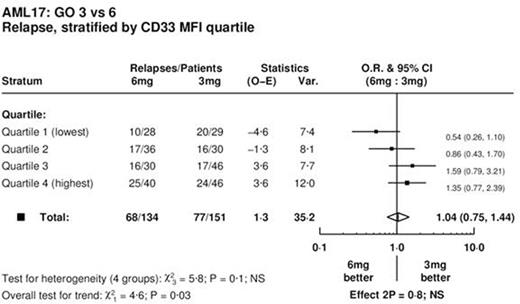Abstract
On behalf of the UK NCRI AML Working Group
CD33 was the first target for antibody directed therapy in any cancer with further CD33-directed strategies, including bispecific or chimeric antigen receptors, in development in AML. Our previous meta-analysis results with the first anti-CD33 antibody conjugate Gemtuzumab Ozogamicin (GO) demonstrated the importance of appropriately defining patient subgroups (e.g. by cytogenetics) that may most benefit from this therapy and as such provides a paradigm for other antibody-directed agents. However in adult AML there is limited data on whether CD33 expression levels (for total blasts and any 'immature' CD34+CD38- blasts) contribute to GO response, taking into account the differences of blast CD33 levels associated with specific genetic abnormalities and that CD33 expression level may potentially be a prognostic factor as suggested by the pediatric AML COG study.
We evaluated the impact of blast CD33 expression levels on prognosis and GO response in adult AML by central standardised flow cytometric analysis of diagnostic samples from 1364 non-APML patients from the UK NCRI AML16 (older patients, n=334, CD33 expression data not an entry requirement) and AML17 (younger patients, n=1030) trials. Both trials included a GO randomisation (AML16 GO vs not, AML17 3mg vs 6mg vs not first induction); in AML17 all CBF AMLs received GO. CD33 mean fluorescent intensity was quantified for overall blast population (blast CD33 MFI) and CD34+CD38- subset (potentially enriched for leukemic stem cells) (CD33 MFI of CD34+CD38-). Percentage CD33negative blasts of WBC (%CD33neg) was also calculated. Patients were divided into quartiles 1-4 (Q1-4) based on increasing values for each of these parameters.
Prevalence of CBF AML (n=152, AML17 only) was inversely associated with high blast CD33 MFI (43% Q1-2, 5% Q4 p<.0001) but MFI levels were also lower for adverse cytogenetics (n=235) (prevalence of non-CBF AML, 55% Q1-2, 10% Q4 p<.0001). Both FLT3 ITD (n=213) and NPM1c (n=322) mutations were more likely to have high (Q3-4) blast CD33 MFI levels even when compared to other intermediate cytogenetic patients (71% of FLT3 ITD in Q3-4 p<.0001; 79% of NPM1c in Q3-4, p<.0001; 40% of non-mutated intermediate in Q3-4). FLT3 ITD and NPM1c were also associated with a low %CD33neg (Q1, <6.5%); FLT3 ITD 37%, NPM1c 43% vs intermediate 20%, CBFs 11%, adverse 16%.
In univariate analysis of all patients, higher blast CD33 MFI levels predicted significantly better 5 year OS from entry (Q4 43%, Q2 or 3 36%, Q1 28%, p=0.009): significance was not maintained in analyses adjusted for cytogenetics, FLT3 ITD+, NPM1c, plusage, WBC, performance status, and trial protocol (AML16 vs AML17), although there was an improved CR/CRi (OR 0.81 (0.67-0.97), P=0.02).
321 non-CBF AML patients in our cohort were randomised to GO vs no GO. There was no evidence that CD33 expression levels or percentage of CD33negative blasts or detectable CD33negative CD34+CD38- blasts affected the overall outcome benefit from GO (p=NS for all interactions). There was also no evidence of an interaction between GO treatment and the positive prognostic impact of high CD33.
Blast CD33 parameters did not significantly alter outcome in CBF AMLs (all received GO) suggesting that other biological factors are important for CBF GO sensitivity. Interestingly, despite overall lower blast CD33 levels of CBF AMLs, only 1.4% of these had a detectable CD33neg CD34+CD38- immature population of >0.35% of WBC (mean +2SD normal range of CD34+CD38-) compared to 19% of intermediates and 17% of adverse. This might contribute to the effectiveness of GO (and potentially other CD33-directed therapies) in CBF AMLs since clearance of potential LSCs in the CD34+CD38- subset would not be limited by low CD33 expression.
For the 270 patients in the AML17 GO dose randomisation, relapse risk was improved by the higher 6mg/m2 dose for patients with a low blast CD33 MFI (Q1) (OR 0.54 (0.26-1.10); p=0.03 for trend) with no increase in 60-day mortality (P=0.4) (Figure).
Conclusion Although genetic subgroups have distinct profiles of blast CD33 expression (including low CD33 in both CBF and adverse risk) CD33 levels are not an independent predictor of OS or benefit from GO by adjusted analyses in adult AML. However a higher dose of GO may be more effective at preventing relapse in AMLs with lower blast CD33 expression. These results may be relevant to future CD33-directed strategies.
Off Label Use: Off Label Use: Gemtuzumab Ozogamicin, an antibody-drug conjugate used to treat AML. Russell:Therakos: Other: shares.
Author notes
Asterisk with author names denotes non-ASH members.


This feature is available to Subscribers Only
Sign In or Create an Account Close Modal